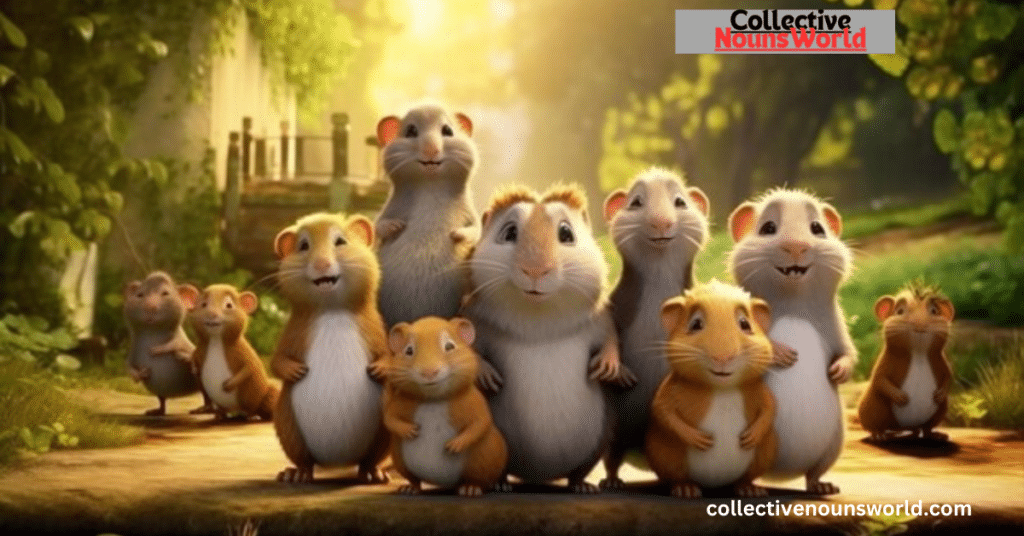Rats have long been a part of human history, often lurking in the shadows of our cities and homes. While many view them with disdain, these intelligent creatures possess a fascinating social structure that’s reflected in the various collective nouns used to describe them. From a mischief of rats to a colony of rats, each term paints a vivid picture of their behavior and habits.
In this article, we’ll dive deep into the wondrous world of rats, exploring their collective names and the scenarios where you might encounter these remarkable rodents in groups. We’ll uncover the reasons behind their social behavior and how it influences their survival in diverse environments.
Before we embark on this journey, let’s take a quick look at the most common collective nouns for rats:
| Collective Noun | Description |
| Mischief of rats | Emphasizes their playful and troublesome nature |
| Colony of rats | Highlights their communal living arrangements |
| Pack of rats | Suggests a more predatory or organized group |
| Swarm of rats | Indicates a large, moving mass of rats |
| Horde of rats | Implies an overwhelming number of rats |
Now, let’s explore each of these terms in detail and discover the fascinating world of rat social structures.
The Mischievous Nature: A Mischief of Rats
When you hear the phrase “a mischief of rats,” you can’t help but imagine a group of these clever creatures up to no good. This collective noun perfectly captures the playful yet sometimes troublesome nature of rats.
Picture this scenario:
From: Sarah Johnson sarah.j@citymail.com To: Building Management management@highrisecorp.com Subject: Urgent – Mischief in the Break Room
Dear Building Management,
I hope this email finds you well. I’m writing to report an unusual situation in our 5th-floor break room. This morning, I walked in to find what I can only describe as a mischief of rats having a field day with our snack supplies!
These little rascals had somehow managed to open the cabinet doors and were feasting on cookies, crackers, and even attempting to operate the coffee machine. While I must admit it was quite a sight to behold, I’m concerned about hygiene and potential damage to our facilities.
Could you please send someone to assess the situation and implement appropriate measures to prevent future incidents? It seems our furry friends have found a way to turn our break room into their personal playground.
Thank you for your prompt attention to this matter.
Best regards, Sarah Johnson Marketing Department
This email perfectly illustrates how rats’ social behavior can lead to amusing yet problematic situations. A mischief of rats often works together, using their collective intelligence to solve problems and access food sources. Their pack behavior allows them to tackle challenges that a single rat might find impossible.
Building a Home: A Colony of Rats
The term “colony of rats” brings to mind a more structured and permanent arrangement. Rats are known for their communal living, often establishing complex underground networks or setting up shop in abandoned buildings.
Let’s explore a fictional news article that highlights this aspect of rat behavior:
Read more The Amazing Collective Noun for Cows
Local News: Ancient Colony of Rats Discovered in Abandoned Factory
MILLBROOK, OH – Construction workers renovating the old Millbrook Textile Factory stumbled upon an extraordinary find this week – a vast colony of rats that had been thriving undisturbed for decades.
“I’ve never seen anything like it,” said foreman Jack Thompson. “We were tearing down a wall when we uncovered this intricate network of tunnels and nests. It was like a rat city down there.”
Experts estimate the colony could house hundreds, if not thousands, of rats. Dr. Emily Rodgers, a local biologist specializing in urban wildlife, was called to the scene.
“This discovery provides a unique opportunity to study rats’ social structures in a long-established colony,” Dr. Rodgers explained. “We can learn a lot about their hierarchies, breeding patterns, and how they’ve adapted to this industrial environment.”
The find has sparked debate among city officials about how to proceed with the renovation project while preserving this remarkable example of rats’ communal living.
As we can see from this article, a colony of rats can create complex social structures that mirror human societies in many ways. They establish territories, create communal nesting areas, and work together to ensure the survival of their group.
Strength in Numbers: A Pack of Rats
While we often associate the term “pack” with wolves or dogs, a pack of rats is a formidable force in its own right. This collective noun emphasizes the organized and sometimes predatory nature of rats when they band together.
Consider this fictional excerpt from a nature documentary script:
Narrator: As night falls on the bustling metropolis, a different kind of citizen emerges from the shadows. A pack of rats, led by a battle-scarred alpha, ventures out into the neon-lit streets.
These urban survivors move with purpose, their whiskers twitching as they seek out the night’s bounty. Rats scavenging for food is a common sight, but this pack operates with military precision.
Watch as they approach a row of garbage cans. The alpha rat stands guard while others work to topple the metal cylinders. Within moments, the pack swarms over the spilled refuse, each member playing its part in this well-orchestrated feast.
But it’s not all about food. This pack also serves as a defensive unit. When a stray cat approaches, the rats don’t flee. Instead, they form a tight circle, their collective strength enough to give even this feline predator pause.
This remarkable display of pack behavior in rats showcases their adaptability and the power of their social bonds. In the unforgiving urban jungle, it’s clear that these rats have learned that survival often depends on strength in numbers.
This scenario illustrates how a pack of rats can work together, not just for scavenging but also for protecting their territory. Their ability to organize and cooperate gives them a significant advantage in harsh urban environments.
Read more What is the Collective Noun for Papers?
A Moving Mass: Swarm of Rats
The term “swarm of rats” evokes images of a large, moving mass of rodents. This collective noun is often used to describe situations where rats are seen in great numbers, typically in motion.
Let’s examine a fictional emergency response report that demonstrates this phenomenon:
INCIDENT REPORT Date: 07/15/2024 Location: Oakville Subway Station Reporting Officer: Lt. Maria Sanchez
At approximately 22:30 hours, dispatch received multiple calls reporting a large group of rats in the Oakville Subway Station. Upon arrival, officers witnessed what can only be described as a swarm of rats moving through the station.
Eyewitness accounts suggest the swarm emerged from the tunnels, possibly driven out by ongoing maintenance work. The rats moved as one entity, flowing across the platform and up the stairs to street level.
Public Works was immediately notified. They theorize that the rats moving together in such large numbers may be a result of rats in the sewer system being displaced by recent heavy rains.
The station was evacuated and closed for public safety. Animal Control has been called in to assess the situation and implement a humane removal strategy.
This incident highlights the need for improved pest control measures in our underground transit system to prevent future occurrences of this nature.
This report showcases how a swarm of rats can create chaos in urban environments. It also touches on the interconnectedness of urban infrastructure and how disruptions in one area (like sewers) can lead to unexpected consequences elsewhere.
Read more Fun with Collective Noun for Shoes
An Overwhelming Presence: Horde of Rats
The term “horde of rats” suggests an overwhelming number, often associated with infestations or situations where rats have multiplied unchecked.
Consider this fictional excerpt from a historical journal:
September 15, 1854
Today, I witnessed a sight that shall forever be etched in my memory. As our expedition approached the ruins of the ancient temple, we were met not by the echoes of long-lost civilizations, but by the chittering of countless tiny voices.
From every crevice, every shadowed corner, poured forth a horde of rats. Their numbers were beyond counting, a living carpet that flowed over the crumbling stones. This was no mere colony or pack, but a veritable army of rodents that had claimed this forgotten place as their domain.
In all my years of exploration, I have never encountered such a phenomenon. The sheer mass of rats in abandoned places like this speaks to their remarkable ability to thrive where other creatures falter.
As we hastily retreated, I couldn’t help but marvel at the rats’ social structures that must exist to maintain such a vast population. What hierarchies, what complex interactions must occur within this teeming horde?
While our archaeological pursuits may be temporarily thwarted, I find myself oddly excited by this unexpected turn of events. Perhaps there is more to learn from these resilient creatures than we ever imagined.
This journal entry paints a vivid picture of a horde of rats, showcasing their ability to dominate environments that humans have long abandoned. It also touches on the fascination that these adaptable creatures can inspire, even in overwhelming numbers.
Read more What is the Collective Noun for Girl?
Conclusion: The Collective Power of Rats
As we’ve explored the various collective nouns for rats – from a mischief to a horde – we’ve uncovered the complex and fascinating world of these often-misunderstood creatures. Each term reflects a different aspect of rats’ social behavior and their remarkable ability to adapt and thrive in diverse environments.
Whether we encounter them as a colony of rats in an abandoned building, a pack of rats scavenging for food in city alleys, or a swarm of rats moving through urban infrastructure, these rodents continually demonstrate their intelligence and social cohesion.
Understanding the collective behavior of rats is not just a matter of linguistic curiosity. It provides valuable insights into urban wildlife management, pest control strategies, and even the study of social structures in mammals. By recognizing the complexity of rat societies, we can develop more effective and humane ways of coexisting with these resilient creatures.
So, the next time you spot a group of rats, take a moment to appreciate the intricate social dance you’re witnessing. Whether it’s a mischief causing trouble or a colony building a home, these collective rats are playing out age-old social behaviors that have ensured their survival for millennia.
In the end, the wondrous world of rats and their collective names remind us of the rich diversity of life that surrounds us, even in the most unexpected places. It’s a testament to the enduring power of social cooperation and adaptability in the animal kingdom.

Luna Jasper is an experienced blogger with a passion for language and grammar. At **Collective Nouns World**, she shares her expertise in exploring the fascinating world of collective nouns, making learning both engaging and fun. With years of writing and research under her belt, Luna’s insightful articles help readers understand and appreciate the English language.







